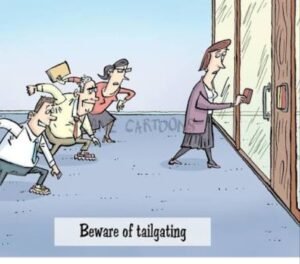Concept behind Tailgating
Tailgating is one of the most common courtesies and innocent risks in security breaches. Tailgating which is also known as piggybacking is one of the most widespread security breaches affecting businesses of the present age. Very often it is described as the gate of unauthorized personnel, either forced or accidental, behind that of an authorized user. Tailgating costs businesses losses in revenue from long term damage to their brand and reputation along with putting the property, data, and occupants of an organization at risk. For service industries such as the leisure industry, where controlled access is required, this can result in a big loss of revenue.

KEY POINTS
Tailgating is said to be done when brokers or financial advisors profit by placing orders on their own account by making use of information provided by customers for their trades.
It is not considered as illegal but is highly unethical.
Deep understanding of Tailgating
Tailgating, a highly unethical act but is legal. Though often, It is easily confused with two other investment-related actions, both of which are illegal. While it may appear similar, tailgating is not the same thing as the practice of insider trading, investors and practitioners should be aware of it. We can understand it as, Insider trading occurs when the sale or purchase of a security arises from confidential, or proprietary, information, tailgating takes place when the broker takes a cue or trade request from the client with the client’s own information and then places the same trade for his own account based on the information the client provided. An employee opening a door and holding it open for others, visitors without badges or the passive acceptance of a uniformed worker is allowed, then in simple words, it is tailgating. The problem with these situations and common courtesy is that they open your building to unauthorized and undocumented entry by individuals who could intend harm to your employees and property too.

What are the dangers of tailgating at the workplace
Nowadays, It’s a common problem. A recent survey conducted by Boon Edam found that over 70% of respondents believe they are currently vulnerable to a security breach from tailgating. It might often innocently carried out unintentionally by an employee politely holding a door open for someone, a visitor without a badge, or someone in a uniform appears to be a worker. It may seem like a harmless gesture and something you would do without even thinking twice about, however, these lapses in security have the potential to cause great damage to a business. These attempted breaches are often so successful as it is easy to assume that an individual entering a workplace is an employee or a contractor. Fraudsters know that it will make employees uncomfortable to confront strangers or deny them access, especially if it’s a large organization with part-time or full-time working staff or contractors. If a fraudster gains fraud access, their intent could be anything ranging from theft of equipment, theft of sensitive hardware, unauthorized access to the company’s internal systems, physical acts of violence or access to intellectual property and even many more. This would result in financial loss and damage to the reputation of concerned organizations and companies. If an organization is having a weak security system, it may be viewed as being weak and deficient in other areas too. These consequences of a security breach are much worse than simply asking to see someone’s ID badge or sign them into the common building.
- What can you do to prevent tailgating
There are a few steps that can be taken to prevent tailgating to some extent. - Educate users on the risks associated with tailgating and have a clear policy in place with guidelines and procedures on what to do when any unauthorized person gains access to the company’s private sphere.
- Always be aware of anyone following you through the door. Politely greet them and escort them to their correct location and belongings.
- Bring quick attention to any individual you see trying to slip through security measures of related organization.
- Don’t let the door open for anyone unauthorized.
- If you find any suspicious individuals, report to the relevant personnel
- If a door does not shut properly or automatically close, then report it to security
- Security is the responsibility of every single individual within an organization. Establish a security culture that encourages employees to think and act in a security-conscious manner and recognize the devastating impact a security breach could have on them and the company too.
By ensuring that simple security behaviors fulfillment, the overall level of security within an organization can be dramatically improved. Before your security is breached, Meesons’ anti-tailgating solutions can help you eliminate the threat of unauthorized access at the point of entry. It’s necessary to be aware of your surroundings and question anything you find suspicious because the reality is that a crime can be committed by someone you didn’t even know was in your building.


